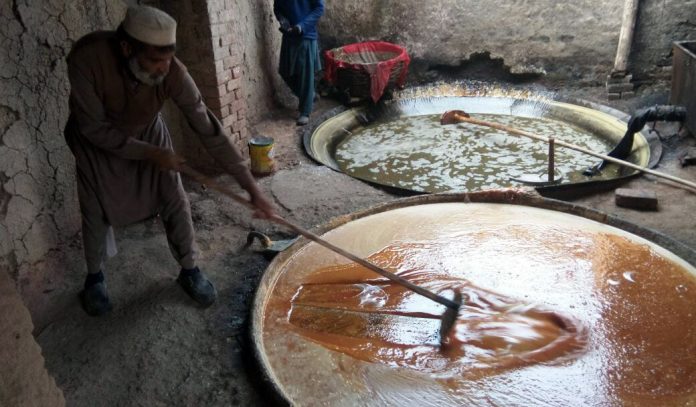Charsadda: Ganrhi (Jaggery-making), the traditional small industries for Gur production are centuries’ old practice across Khyber Pakhtunkhwa’s agriculture rich districts. Thousands of miles covered with sugar-cane corps would not only make their ways to Sugar mills alone, much of them would be squeezed by simple machinery and then baked till it becomes Gurr (jaggery).
Gorhi [Gurr-Maker] Amanullah aka Ghazi, in his 60s with grey beard and white cultural cap is busy in early morning while instructing his four subordinates to keep their duties on with full focus and energies. “We get up early in the morning at 5 O’clock, the Ganrhi [Gur industry] work starts on and going on till late in the evening, we have just some four months [November to the start of March] to juice the ripen sugar cane and convert them into yellow slices of Gurr”.
Sugarcane are grown in the beginning of the year. Then ripe up and harvested through the hard work of the peasants who makes them into bunches ready for their road to Ganrhi, most of these canes collected through hard work of human resource using bull or donkey carts. Where in the “Ganrhi” a different staff of 7 to 8 members waiting to take them for the Gur producing further process.
Ganrhi which used to be much slower and defended upon human and animals hard work alone is now run through a Chinese machine with an extension of heavy iron gears and circulating around each other that are given a small divided bunch of the sugar cane. Which grind the sugarcanes and juice out the light green natural sugar runs through an iron pipe down straight into a rectangle pool, of one meter in volume, for storage.
After the pool is filled, then it is opened through a rubber valve, made up of the bike tube, into the large round baking pan of a 10 square feet diameter. The pool, boiling pan and cooling mud pan [two different pieces] are all inside the muddy room, having a celling of sugarcane bushes and half of the size of the room is an open celling, the exhaust to let the boiled water up in the air, that produces a sweet smell.
Half of the room under the boiling pan is warmed through the straws and juiced sugarcane bushes with a hole outside the room. Where a standing man called “Jogi” from the 7 men is busy in throwing down the dried juiced sugarcane bushes and straws to keep the temperature up, this way the hot boiling pan is letting huge moisture up in the air.
The sugarcanes are neither washed nor cleared from its stick covered with black spots and earth hap articles and dust. Amanullah says, “We throw in the baking soda, that increase the boiling of sugar juice and the smaller particles goes up in a corner are then taken out through a long stick with a collecting filter or big spoon.”
After two and half hour, the Gur gives its orange color and the fully filled pan is now looking half filled, the boiling density slows down. Amanullah aka Ghazi go around it and throws down a table spoon into the pan for keeping the softness of the Gur.
Khalid Khan Mohammadzai is the land lord who’s the man behind all the business but is tense over the attitude of government for not supporting the land lords and keeping the prices of their Gur up. “Our lands are now converting into housing schemes, because nothing comes into our accounts instead of being busy round the year we get mere sum of 5000 PKR for a bag of 100 KG Gur”.
Khan is of the view that everything in the market has touched the sky but it’s Gur that’s priced with the same amount now for years. He’s forced to pay the prices of ingredients to plough the land, seeds, urea and the daily or monthly wages of his working peasants. [Rule of the peasantry in Khyber Pakhtunkhwa].
The stuff is so pure, “Baking soda, is added to the pool for boiling it up and making us able to collect the small particles come up that are collected with a filter made up of plan one-foot pot with many holes”, says Amanullah. “Ghee or oil per table spoon for the whole pool is added to make the Gur soft and crispy when it is used”.
The large Ceramics pot is for the cooling where ready hot sugar is poured through another collecting [Lota] into the pot and here the final stag come, when it is yet to cool the work for collecting it with iron large flat spoons and two heavy heaps condenses up. Amanullah shouts on his guys “Come-on and it’s ready”, then they start making half of the cricket like irregular balls with a hurry, using water to cool their hands and speed up the Gur ball making. “Now it’s ready and would go to sugar bags in an hour”.
All across Khyber Pakhtunkhwa, “50 thousand 100 KG bags of Gur are produced and brought into the market on daily basis in the four-month season [November till the end of February]”, says Shabir Haji, in his 70s, the general secretary of All Gur Traders Association Pakistan.
“Around 2000 Ganrhis [Gur processing traditional industries] are active across the province, the Gur are in three different categories, the first quality is used for different purposes and largely utilized by the people instead of Sugar, the second categories are either used in Wine and for animals’ eatery, the third category is mainly used in cigarette factories”, Shabir told.
According to Shabir the majority of Khyber Pakhtunkhwa produced Gur was popular in Afghanistan and rest of the Central Asian nations for its different taste and quality. “Alas, we have lost the market owing to politics between countries and now the Gur 100 KG bag that had a price of 6000 PKRs is now sold with 4000 PKRs only”.
The down prices have no doubt shocked the people connected to the business, the most vulnerable are the 12 to 14 thousand “marginalized” people who are not having another business other than defending on the “Ganrhi and Gur production”, told Jalal Khan a doctorate scholar of anthropology at University of Peshawar. “No doubt people from across Khyber Pakhtunkhwa are connected with this local industry for centuries, and they are not only keeping their families live upon the Gur income, they provide a big demand of the market in the form of Gur production”. These are not only individuals each of the active member in this business is having a complete family to raise upon his income through the Gur market.
The Afghanistan market is now filled with “Indian Gur” that comes through Chabahar. But the Gur from Peshawar market is far like the demand of Afghan masses, here they don’t make the choice these are governments who let which Gur they should have “Indian or Pakistani”, that affects us so badly, told Haji Shabir. “The grievances of the landowners are no doubt true, but we the middle men or traders are not downing the price of the Gur it is the international market we lost decide the price of our Gur”.
Nazeef Lala, is the labor and peasant union activist is of the view that the huge sum of sugar now produced globally is also affecting the Gur industry as more and more people in the “urbanized” centers have switched to use Sugar instead of their “traditional sweet Gur” this is another factor causing and downing the Gur market which will surely push the land lords to stop the business anymore and use their large lands either for “housing scheme” and other buildings and construction. “This will no doubt be affecting the labors and peasants lot who are not skilled to find another job to ‘starve before the capitalist market’”.
Khalid Khan is of the view unless they’re provided with a market of giving them enough value of their “Gur” they [landlords] are forced to change their idea and stop the centuries old business anymore. “Government can provide us subsidies, and good relations with the business markets in Afghanistan and Central Asian countries to again raise up the Gur rates that way”.




